Tokyo Tidbits: The Birth of Gochiso, An Upscale Pop-Up

“Are we really doing this?” I asked, uncertainly nibbling on a grilled shiitake mushroom.
Eriko paused before answering. “I know I was talking some pretty ambitious stuff the other night, but I think we should try it,” she replied. “We could end up pulling off something really cool.”
I vividly recall the tipsy conversation that had brought the Gochiso project into the world. At that time, the words “frisson,” “anti-establishment,” and “Lady Gaga” were being bandied about with Champagne-fueled gusto.
Like a lot of great inventions, Gochiso was the fruit of secondary fermentation (in more ways than one). We were at a barbeque in early May at my homeslice Robert’s place in Shibuya, sipping wine and talking food--the subject of most of my conversations with Eriko and Chihiro. The three of us had met through mutual friends but food was the link that bound us. Eriko is a filmmaker with a soft spot for Perrier-Jouet and caviar; Chihiro is a graphic designer who’s worked with Michelin stars; and I’m a journalist who writes about food, sake, and wine. Earlier in the year we’d formed an unofficial “gourmet club” to eat, drink, and gossip.
I was excited about a pop-up dinner I’d attended in London and couldn’t stop chewing their ears off about it. We all agreed that the upscale food scene here in Tokyo was in danger of becoming stale, and we wanted to shake things up. Part of the problem is the hierarchical nature of the business, but things are doubly hard for young chefs who stray from the norm in Japan.
“It’s such a shame, isn’t it?” Chihiro carefully wrapped her rib in a paper napkin and took a small bite. “We must have a lot of talent in Japan that have lost their motivation.”
“Everyone’s kind of doing the same thing,” I continued. “It seems that young chefs who want to do something experimental tend to go abroad.”
“You know what? We can do this,” Eriko said. Within moments, she had put on her Pop-Up Producer’s hat. “We need to do this.”
Two weeks later, we were moving seriously toward making this crazy idea a reality. Eriko found the perfect chef to work with for our first event, and we set the launch for June 25th. Maria Suzuki is a tough lady with the right culinary pedigree, and it just so happened that she’d recently left her restaurant job to become a private chef. Once Chef Suzuki came on board, everything else seemed to fall into place. Robert had offered to host the dinner at his house, so we came up with the title Make Yourself At Home to give the event a conceptual structure.
I reached out to friends in the drinks biz to provide us with great wine and sake. Chihiro introduced us to a vegetable vendor who also supplies some of Tokyo’s Michelin-starred restaurants with top-quality produce. And we had a list of people who wanted to come.
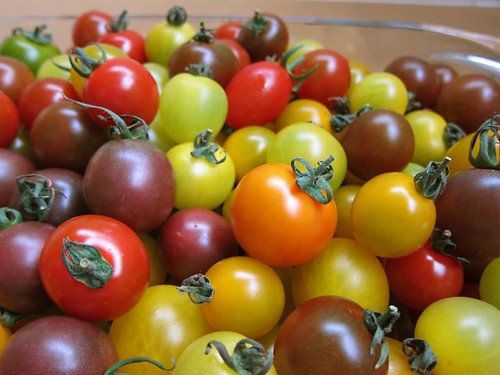
Then, things started to get complicated. The white asparagus Chef Suzuki had requested proved to be elusive and pricey. Our guest list swelled from the 10 to 14, which meant that we had to figure out a creative way to seat everyone. Needless to say, Robert didn’t have table settings for that many people, and Chef Suzuki’s multi-course menu would require several dishes of different sizes for each person.
In the end, we each ferried bits and pieces of our own homes to the venue. Chihiro brought Champagne flutes, cutlery, and sweet-smelling hydrangea leaves from her garden that would serve as fork rests. Eriko brought bowls and plates. I, too, brought plates, plus the ochoko (sake cups) that Chef Suzuki used to serve her amuse bouche of uni mousse. I also shipped over my kitchen table, which we set up in the loft space of Robert’s living room to give four of our diners a bird’s eye view of the kitchen.
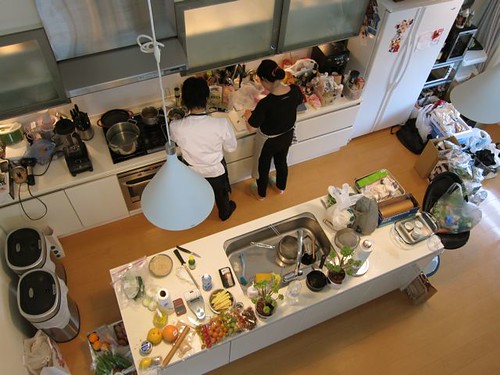
And, thanks to some vegetable sleuthing by Agrigraph, we got our hands on white asparagus just in the nick of time--a box of plump, fresh spears tinged with the faintest blush of pink.
The day of the dinner was not without its glitches, though. The menus, which were designed to look like Japanese books, needed to be sewn, but the machine broke halfway through the batch. Of course.

Chef Suzuki needed to make some last-minute adjustments to the recipes, but, apart from that, things were going pretty smoothly despite our nerves.
Once our guests arrived and we’d served (and imbibed) our first cocktails, the three of us eased into the natural rhythm of a dinner party. After all, that’s basically what it was, and if there’s one thing I do well, it’s hosting a dinner party. What made this event truly special though, was the stunning food that Chef Suzuki brought to the table, paired with wines chosen by Michael Khoo of WineInStyle.
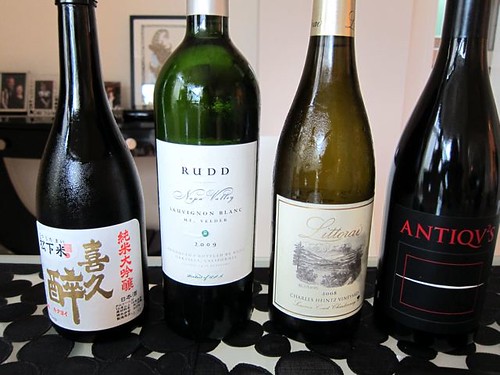
The dishes were creative and beautifully presented, reflecting Chef Suzuki’s background in classical French and modern Spanish cuisine but in keeping with the “homey” theme of our event. Dinner began with one crispy bite of breaded and deep-fried hamo eel, topped with mikan (tangerine) espuma, and served alongside a silky, pudding-like uni mousse.
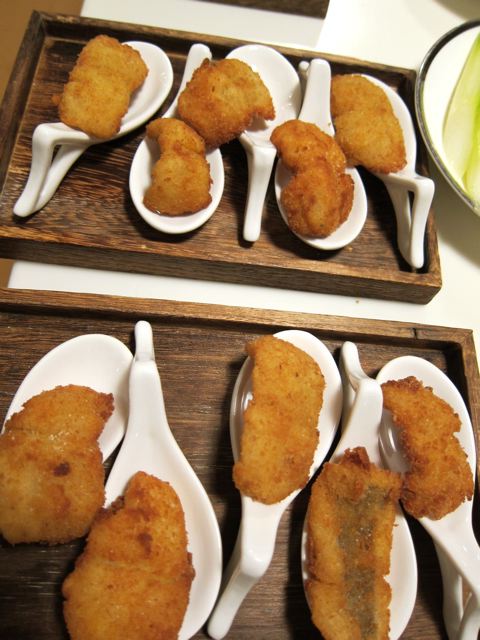
This was paired with Aoshima Shuzo’s organic Kikuyoi Matsushita-mai Junmai Daiginjo sake from Fujieda City in Shizuoka, an aromatic brew with a fine, light texture and slightly astringent herbal notes in the finish.

Hamo, a specialty of Kansai, is infamous for its myriad of pesky, bristling bones. Chefs bold enough to cook with hamo must first master the technique of cutting it, which is unsurprisingly complicated and tricky.
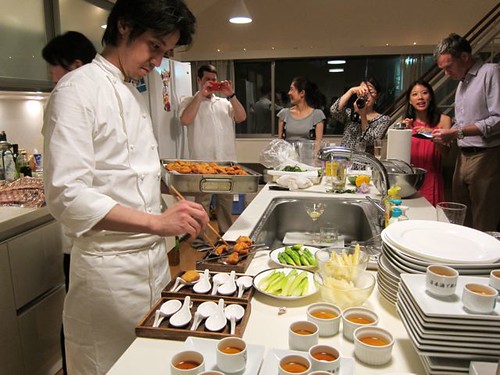
One of the most visually striking courses was an appetizer of green and white asparagus (from Tochigi and Shizuoka) simmered in a citrus bath.

Chef Suzuki arranged the spears beneath wispy sheets of dried scallop and ribbons of raw scallop, and then sprinkled the dish with dainty white carrot flowers. It was so pretty you almost didn’t want to eat it, and great with the full-bodied Argyle Willamette Brut sparkling wine.
Perhaps my favorite dish of the evening was the roasted sea bass in truffle-Champagne sauce, nestled in a bed of slippery oats and sweet onion petals.
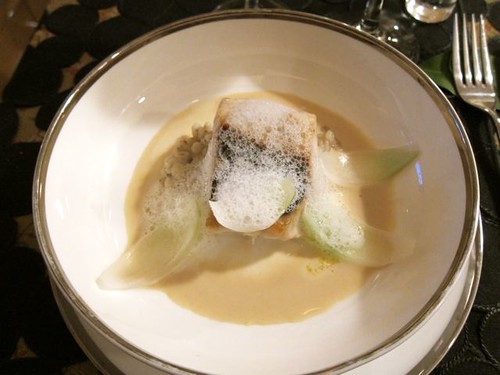
I’m a sucker for truffle sauce, and the fish was perfectly moist and flaky. The wine pairing rocked: Littorai Charles Heintz Chardonnay ’08. Together, it was like a little glimpse of heaven.
It all went remarkably well. Our diners left happy, wowed by the food and wine and in love with the concept. For a full look at the menu and wine tasting notes, check out my blog, Tokyo through the Drinking Glass. (Please also 'Like' Gochiso on our Facebook page!)
After we'd cleared all of the plates and glasses, Chef Maria and her assistant Tsutomu Otsuka could finally let their hair down. At 3am, Robert pulled out a block of foie gras pate from his secret stash.
"My feet," Maria announced, massaging her instep, "are throbbing."
Eriko looked up from punching numbers into her laptop and smiled. "Cheers," she said. "We did it."
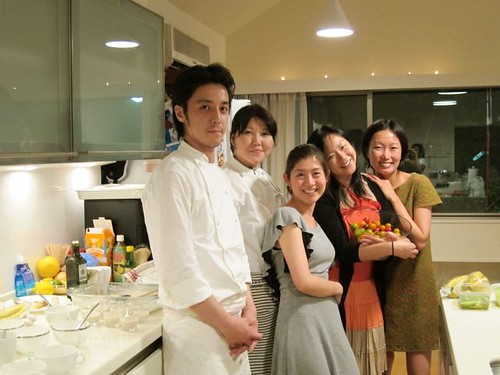
From left: Tsutomu Otsuka, Chef Maria Suzuki, Chihiro, me, Eriko.
Each guest had paid ¥11,000 (about $130) for dinner and drinks, but every thin yen went into producing the event. The point of Gochiso isn't to turn a profit; it's to start a dialogue and spread the word about emerging culinary talent.
When people say that money is the root of all evil, they usually mean that having lots of money makes people do bad things. But having no money brings its own share of problems. We were putting this together on a shoestring--and I’m not talking about the fat kind that old-school rappers used to lace through their Adidas shell-tops. Our budget was tight, and we found ourselves troubleshooting constantly to keep finances within bounds.
Was it all a pain in the ass? Yes. Was it worth it? Absolutely.
Now we have our hands full with preparations for the next event, Food Is Art, which we plan to hold at the gallery Art Statements in a few weeks. It’s a huge challenge, and the food will be very experimental, but we know Maria is up to the task. The days are whizzing by, and heaven help us we’re still looking for a kitchen.
Every day, something happens. But we can’t wait to see what these Chef will create this time.
*Melinda Joe is an American journalist in Tokyo specializing in food, drinks, and travel. A certified wine and sake professional, she chronicles her adventures in food, sake, and wine on her blog Tokyo through the Drinking Glass.
